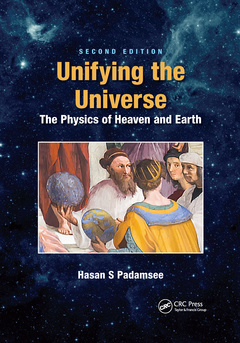Unifying the Universe (2nd Ed.) The Physics of Heaven and Earth
Auteur : Padamsee Hasan S.

Unifying the Universe: The Physics of Heaven and Earth presents a non-technical approach to physics for the lay-science enthusiast. This popular textbook, which evolved from a conceptual course at Cornell University, is intended for non-science undergraduate students taking their first physics module.
This second edition maintains its unique approach in crossing boundaries between physics and humanities, with connections to art, poetry, history, and philosophy. It explores how the process of scientific thought is inextricably linked with cultural, creative, and aesthetic aspects of human endeavor, opening the readers up to new ways of looking at the world.
The text has been fully updated throughout to address current and exciting new topics in the field, such as exo-planets, the accelerating Universe, dark matter, dark energy, gravitational waves, super-symmetry, string theory, big bang cosmology, and the Higgs boson. There is also an entirely new chapter on the Quantum World, which connects the fascinating topics of quantum entanglement and quantum computing.
Key Features:
- Provides a solid, yet accessible, background to basic physics without complex mathematics
- Uses a human interest approach to show how science is significant for more than its technological consequences
- Discusses the arts and philosophies of historical periods that are pertinent to the subject
Part 1: The Earth. 1. The Shapes of Nature: Beginnings of Scientific Thought. 2. Matter in Motion - An Elementary Quest: Beyond Reason and Observation. 3. Science Lost, Science Regained: The Rise of Empiricism. 4. Terrestrial Motion: Dynamic Symmetries. Part 2: The Heavens. 5. Celestial Motion: A Heavenly Romance with the Solar System. 6. Spherical Models: Scaling the Cosmos. 7. Reformation and Revolution: Changing Perspectives. 8. Laws of Motion in the Heavens: Opening New Doors through Precision. 9. A New Heaven: A Wide-Open Universe. Part 3: Synthesis. 10. Rise of the Mechanical Universe: Unifying Space and Time. 11. Universal Gravitation: The First Synthesis. 12. Quantum Wonderland. 13. Unity in Physics.
Hasan Padamsee is a Professor at Cornell University. He received his BS in Physics from Brandeis University in 1967, and his PhD in Physics from Northeastern University, Boston Mass, in 1973. He later worked at Cornell University in Superconducting Radio Frequency (SRF) science and technology, creating applications for particle accelerators. In 1990, he launched the TeV Energy Superconducting Linear Accelerator (TESLA) which morphed into the TESLA collaboration headed by DESY, and subsequently into the International Linear Collider (ILC). Prof Padamsee received the IEEE Particle Accelerator and Science Technology (PAST) in 2012 and the APS Robert R. Wilson Prize for Achievement in the Physics of Particle Accelerators in 2015. In 2014, Fermilab appointed Prof. Padamsee as the Head of the Technical Division to oversee the development of SRF for the Linac Coherent Light Source –II at SLAC, as well as for Proton Improvement Program (PIP-II) at Fermilab.
Date de parution : 09-2021
17.8x25.4 cm
Disponible chez l'éditeur (délai d'approvisionnement : 14 jours).
Prix indicatif 56,31 €
Ajouter au panierDate de parution : 02-2020
17.8x25.4 cm
Thèmes d’Unifying the Universe :
Mots-clés :
Young Man; Pole Star; Introductory physics; Red Dwarf Star; General physics; Large Magellanic Cloud; Earth; Island Universe; Literature; Type Ia Supernova; Science; Centripetal Acceleration; Art; Zodiac Constellations; accelerating universe; Intrinsic Luminosity; Big Bang cosmology; Higgs Field; exo-planets; CMB; scientific thought; Cosmic Microwave Background; string theory; Magnetic Force; Red Dwarf; Perfect Solids; Sun’s Mass; Free Fall Motion; Globular Clusters; Leyden Jar; Simple Harmonic Motion; Celestial Sphere; Random Static Noise; Gravitational Force; Neutron Star; White Dwarf



